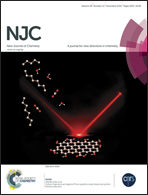Organic–inorganic hybrid materials designed by controlled radical polymerization and mediated using commercial dual functional organophosphorous coupling agents†
Abstract
Hybrid materials that are composed of a polymeric material interfaced with an inorganic, metal oxide material have been a rapidly expanding research area in the last few decades. However, interfacial regions remain an important area of focus, and as such hybrid materials do not always possess a very robust or stable interface. Tailor-made interfacial molecules have been successfully reported but material scientists wishing to develop composite interfacial materials would favorably use commercial solutions. Our study shows how we can leverage a commercially available organophosphonic acid group that is coupled with a 2-bromo isobutyrate initiator for surface initiated atom transfer radical polymerization (SI-ATRP) for use as a strong interfacial molecule. We illustrate this mechanism with both nanoparticles of titania and flat titania substrates used as the grafting support and polymerization anchoring points. We demonstrate that the size of the organophosphonic acid initiator, specifically the carbon spacer between the reactive groups, controls the stability of the molecule. The actual covalent linkage between the phosphonic acid group and the titania surface while also leaving the ATRP initiating group able to start the polymerization, is confirmed via31P solid state NMR spectroscopy, liquid 1H NMR spectroscopy XPS, DLS and SEM.


 Please wait while we load your content...
Please wait while we load your content...